How to use American Sign Language on the trail
- Blog How to use American Sign Language on the trail
Out of all the research on child development, can you think of any one thing that all the studies agree is universally good for kids? I can think of TWO: learning a second language and spending time outdoors. For most of the moms reading this, I assume you have some experience in getting outside with your kids, but not everyone knows where to begin teaching their kids a second language. Well, lucky for us, taking your kids out in nature provides a great starting point to do just that.
Several years ago, I spent time working as an American Sign Language interpreter. After our son was born, we knew we wanted to raise him to be bilingual. Many people know the benefits of teaching sign language to infants for early communication and cognitive development, but rarely do parents continue building on that foundation once their children learn to speak. We found that our love of the outdoors provided access to a wide vocabulary right at our fingertips, which allowed us to continue teaching ASL to our son in a fun and interesting way.
This is a fun outdoor learning activity that you can do, too! Here are some nature-inspired signs to get you started.
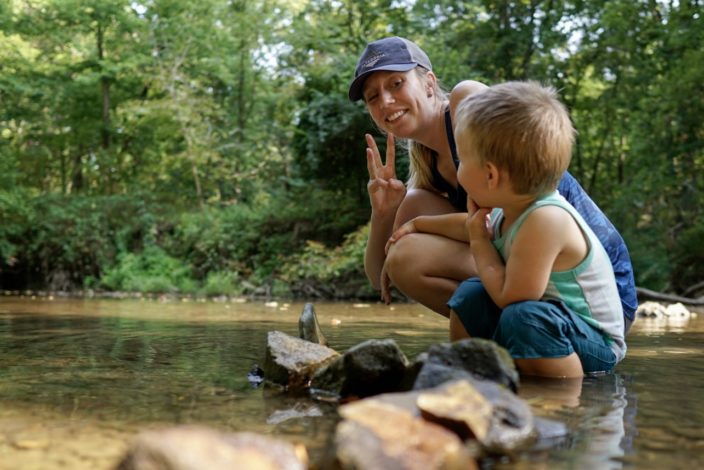
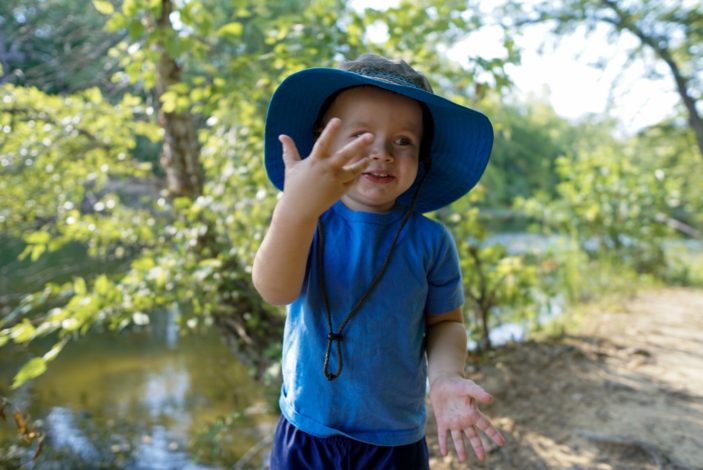
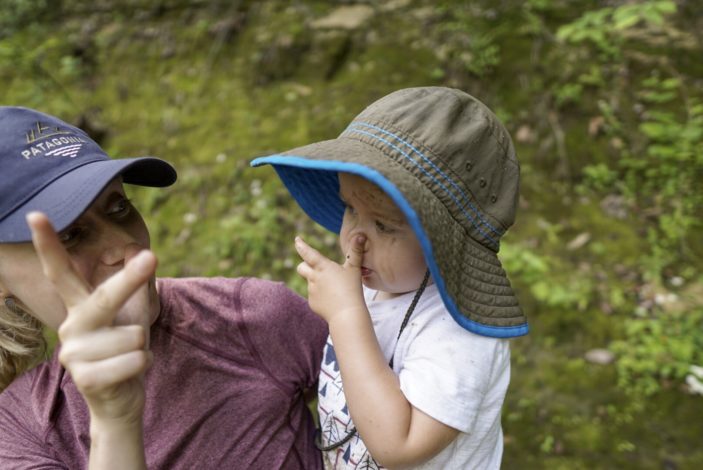
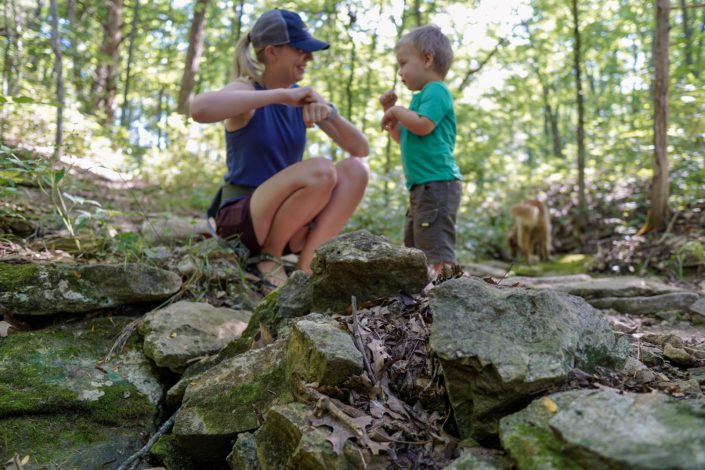
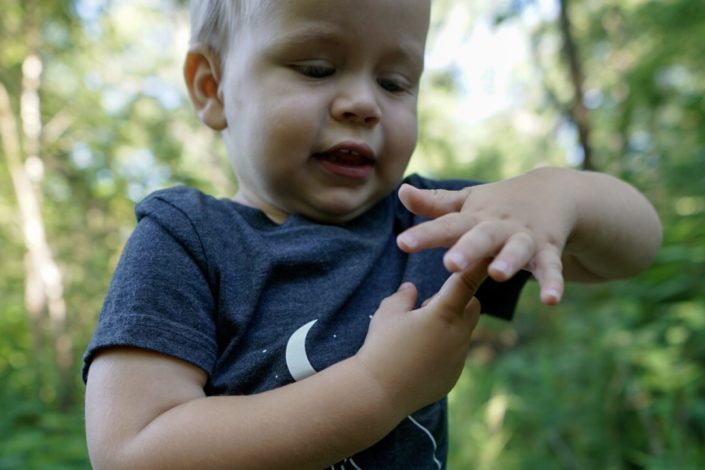 Kids can begin learning ASL at ANY age – even your littlest ones can enjoy it! Don’t fret if they can’t form the signs exactly right. Remember that just like spoken words, it may be difficult for them to form words precisely at first, especially for younger kids with less dexterity. “Tree” was one of the very first signs our son learned, but often his trees appeared to be rolling along the ground! But that’s alright – just keep modeling the signs for them and practicing together.
Even if you have no experience with sign language, the visual nature of ASL makes it fun and intuitive. Pick up an ASL book or DVD from your local library, or tap into the wealth of free online resources available to learn some new signs. Then head outdoors with your kiddos and practice signing together as you point out trees and their leaves, find weird bugs or throw rocks into the water! Follow us on Instagram @hiking.home as we continue to share new outdoors-inspired signs in our Signs of Nature series!
How are some ways you take learning on trail? Please share with us in the comments below.
Kids can begin learning ASL at ANY age – even your littlest ones can enjoy it! Don’t fret if they can’t form the signs exactly right. Remember that just like spoken words, it may be difficult for them to form words precisely at first, especially for younger kids with less dexterity. “Tree” was one of the very first signs our son learned, but often his trees appeared to be rolling along the ground! But that’s alright – just keep modeling the signs for them and practicing together.
Even if you have no experience with sign language, the visual nature of ASL makes it fun and intuitive. Pick up an ASL book or DVD from your local library, or tap into the wealth of free online resources available to learn some new signs. Then head outdoors with your kiddos and practice signing together as you point out trees and their leaves, find weird bugs or throw rocks into the water! Follow us on Instagram @hiking.home as we continue to share new outdoors-inspired signs in our Signs of Nature series!
How are some ways you take learning on trail? Please share with us in the comments below.
Emily is a full-time working mama and wife raised in the Ouachita Mountains and currently navigating life in northern Missouri as she finishes up her PhD in chemistry. Over the years, adventure has become a part of her lifestyle, leading her and her husband, Rocky, into outdoor activities like hiking, scuba diving, camping, kayaking, fly fishing and now parenting – their biggest adventure yet! Now Emily is applying her adventurous spirit to getting her family outside no matter the season to instill that same love of nature and exploration in their 2-year-old son and connecting with other families to inspire them to do the same.
WATER
To produce this sign, create a “W” handshape by extending your middle three fingers with your thumb and pinkie tucked down. Tap your index finger against your chin a few times.
TREE
Hold one arm upright in front of you, bent at the elbow to represent a tree with your elbow as the base, your forearm as the trunk, and your fingers open-palm in a “5” handshape to represent the branches. Holding that position, rotate your wrist back and forth, such that it appears the branches are waving in the wind!
BUG
Form a “3” handshape with your thumb, forefinger and middle finger outstretched, and your ring finger and pinkie both folded down. Place your thumb on your nose, then curl your two other fingers in and out a few times.
ROCK
Form a fist with each hand, palms facing downward. Hit the back of one hand with the knuckles of your other hand, making it appear like you are hitting two rocks together.
LEAF
Hold one hand in an open “5” handshape with your palm facing downward. Place the pointer finger of your other hand under your palm where it meets your wrist to represent the stem. Wave your palm around on the “stem” to make it appear like the leaf is rustling in the wind. Kids can begin learning ASL at ANY age – even your littlest ones can enjoy it! Don’t fret if they can’t form the signs exactly right. Remember that just like spoken words, it may be difficult for them to form words precisely at first, especially for younger kids with less dexterity. “Tree” was one of the very first signs our son learned, but often his trees appeared to be rolling along the ground! But that’s alright – just keep modeling the signs for them and practicing together.
Even if you have no experience with sign language, the visual nature of ASL makes it fun and intuitive. Pick up an ASL book or DVD from your local library, or tap into the wealth of free online resources available to learn some new signs. Then head outdoors with your kiddos and practice signing together as you point out trees and their leaves, find weird bugs or throw rocks into the water! Follow us on Instagram @hiking.home as we continue to share new outdoors-inspired signs in our Signs of Nature series!
How are some ways you take learning on trail? Please share with us in the comments below.
Kids can begin learning ASL at ANY age – even your littlest ones can enjoy it! Don’t fret if they can’t form the signs exactly right. Remember that just like spoken words, it may be difficult for them to form words precisely at first, especially for younger kids with less dexterity. “Tree” was one of the very first signs our son learned, but often his trees appeared to be rolling along the ground! But that’s alright – just keep modeling the signs for them and practicing together.
Even if you have no experience with sign language, the visual nature of ASL makes it fun and intuitive. Pick up an ASL book or DVD from your local library, or tap into the wealth of free online resources available to learn some new signs. Then head outdoors with your kiddos and practice signing together as you point out trees and their leaves, find weird bugs or throw rocks into the water! Follow us on Instagram @hiking.home as we continue to share new outdoors-inspired signs in our Signs of Nature series!
How are some ways you take learning on trail? Please share with us in the comments below.
Read More:
Photos courtesy of Emily Christensen.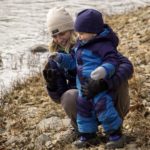 About Emily Christensen
About Emily Christensen
Emily is a full-time working mama and wife raised in the Ouachita Mountains and currently navigating life in northern Missouri as she finishes up her PhD in chemistry. Over the years, adventure has become a part of her lifestyle, leading her and her husband, Rocky, into outdoor activities like hiking, scuba diving, camping, kayaking, fly fishing and now parenting – their biggest adventure yet! Now Emily is applying her adventurous spirit to getting her family outside no matter the season to instill that same love of nature and exploration in their 2-year-old son and connecting with other families to inspire them to do the same.
Related Content




Comments